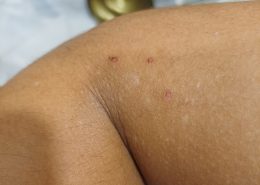is it normal for my child to have nosebleed once every few months? seems to happen randomly as I cant recall any particular triggers
The appearance of bumps on your arm specifically when stressed could be related to a condition known as stress-induced urticaria or hives. This condition occurs when the immune system releases histamines and other chemicals into the bloodstream in response to emotional stress, leading to the formatiRead more
The appearance of bumps on your arm specifically when stressed could be related to a condition known as stress-induced urticaria or hives. This condition occurs when the immune system releases histamines and other chemicals into the bloodstream in response to emotional stress, leading to the formation of hives—raised, itchy welts on the skin.
Here are some relevant insights into this condition and components to consider:
1. Mechanism: Stress can trigger the release of neuropeptides and other factors that influence the immune system, causing the release of histamine from mast cells, leading to hives. These can present as red, raised bumps and are typically itchy.
2. Localization and Triggers: The fact that the bumps appear on a specific area like your arm might be due to localized sensitivity or mechanical pressure in that area, which is exacerbated by stress. This is known as dermographism or pressure urticaria.
3. Diagnosis: It is important to differentiate these from other skin conditions that can mimic hives or are influenced by stress, such as eczema or psoriasis. A healthcare professional can provide a thorough evaluation.
4. Management: Managing stress through techniques such as mindfulness, breathing exercises, or regular physical activity can help reduce symptoms. Over-the-counter antihistamines might also be effective in alleviating symptoms. However, consult with a healthcare provider for a treatment plan suited to your situation.
5. Monitoring and Consultation: Keeping a diary of when these bumps occur in relation to your stress levels and other potential triggers can provide valuable insight. Consult a dermatologist or an allergist for definitive diagnosis and tailored management strategies.
Remember, while stress-induced hives are common, other medical conditions might present similarly, so professional evaluation is recommended to rule out underlying causes.
See less


Nosebleeds in children, known as epistaxis, are quite common and often benign. The frequency you describe—once every few months—can be considered normal in many cases, particularly when episodes are brief, self-limited, and without other concerning symptoms. Here are a few points to consider: 1. ComRead more
Nosebleeds in children, known as epistaxis, are quite common and often benign. The frequency you describe—once every few months—can be considered normal in many cases, particularly when episodes are brief, self-limited, and without other concerning symptoms. Here are a few points to consider:
1. Common Causes:
– Environmental Factors: Dry air or changes in humidity can cause nasal dryness and irritation, leading to nosebleeds.
– Minor Trauma: Activities such as nose picking or minor bumps can frequently trigger nosebleeds in young children.
– Infections or Inflammation: Mild upper respiratory infections or allergies causing nasal congestion can also contribute.
2. Symptoms to Monitor:
– Volume of Bleeding: Minor bleeds that resolve with gentle pressure are less concerning.
– Associated Symptoms: If your child experiences symptoms like frequent bruising, bleeding from other sites, or unusual pallor, it would be advisable to seek medical evaluation.
– Pattern and Triggers: Note any potential triggers and whether the pattern changes, such as increasing frequency or volume.
3. When to Seek Medical Attention:
– For Unexpected Patterns: If nosebleeds become more frequent, severe, or difficult to control, a medical evaluation may be necessary to rule out underlying conditions.
– Possible Underlying Conditions: Rarely, nosebleeds in children can be associated with systemic conditions such as bleeding disorders or, less commonly, structural issues like nasopharyngeal abnormalities.
4. Home Management:
– Humidification: Using a humidifier in your child’s room can help prevent nasal drying.
– Nasal Care: Educating your child about gentle care of the nose, including avoiding nose picking, can reduce trauma-related bleeds.
Remember, while nosebleeds can be a benign and self-resolving issue, if you have any ongoing concerns, or if there are changes in the pattern or severity, it is always a prudent step to consult your healthcare provider for a thorough evaluation.
See less